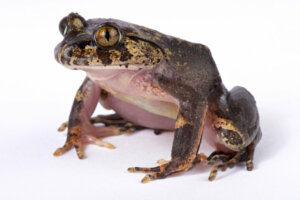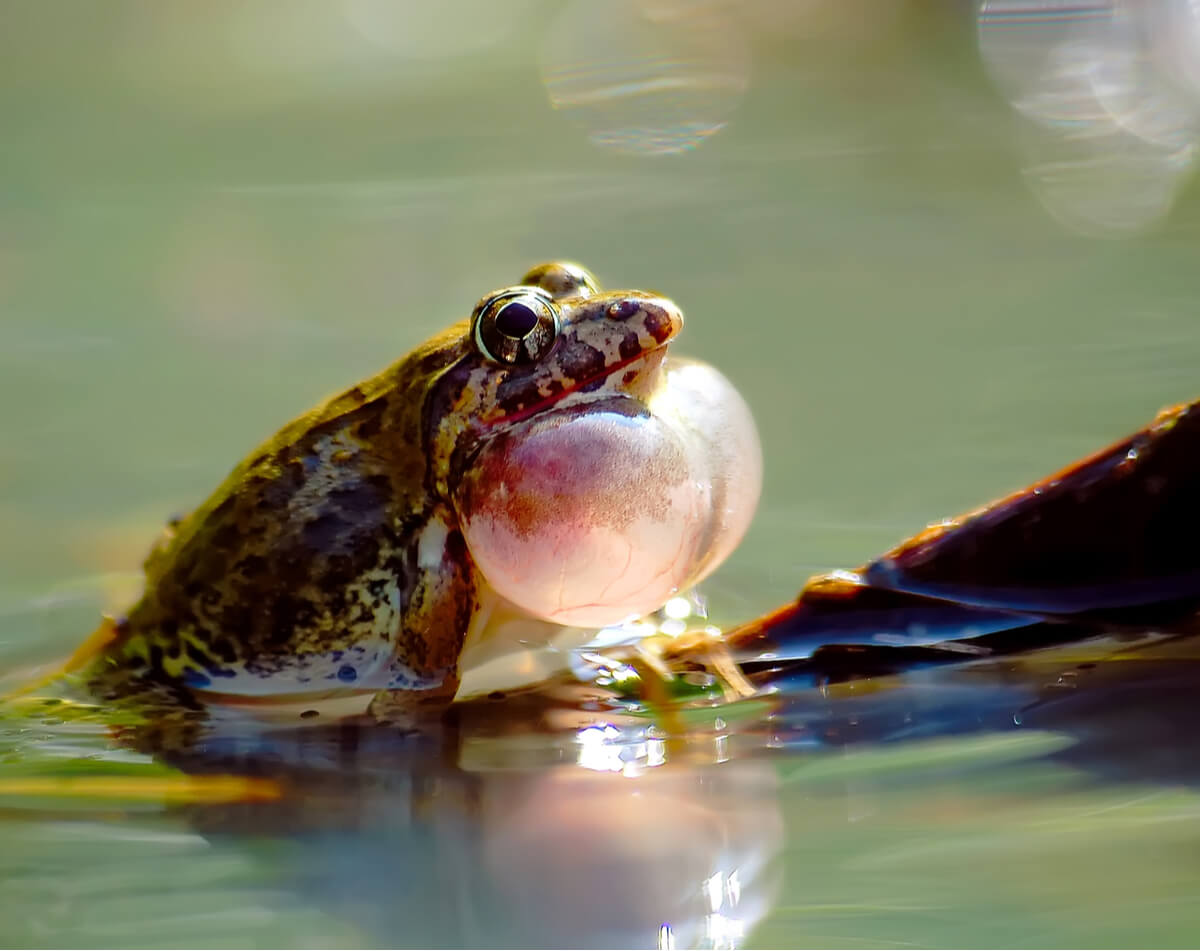Do Frogs with Hair Exist?


Written and verified by the biologist Cesar Paul Gonzalez Gonzalez
Although it seems crazy, there really are frogs with hair. Frogs are amphibians that are characterized by wet and sticky skin. They come in various sizes and colors, and we can even differentiate between frogs and toads. Within all its characteristics, no one imagined that frogs with hair could possibly exist.
Why would a frog need hair? It seems unusual, but these hairs serve an important adaptive role in the biology of these amphibians. If you want to know more about this unique furry animal, keep reading.
What are frogs with hair like?
The species is known as the hairy frog, Trichobatrachus robustus, an amphibian that forms part of the group of anurans. It’s a brown frog, with grayish tones on its belly. Males have hairs on the legs and sides of their body, which can reach up to 19.7 millimeters in length.
Regarding their size and morphology, they measure between 8 and 13 centimeters (3 to 5 inches), the body is oval in shape, and the head is quite large. These frogs with hair are sexually dimorphic regarding their size, and males are larger than females. In addition, they have hidden claws on their fingers, which allow them to defend themselves against predators.
Hairy frogs are native to Africa, and they inhabit areas of Cameroon, Nigeria, Congo, Gabon, and Guinea. They’re usually near rocky rivers with fast current and abundant vegetation. Sometimes they can be found in wooded areas, caves, and forests.

Life and reproduction
In general, frogs usually have a larval stage known as a tadpole, in which they’re completely aquatic and herbivorous. In contrast, adult organisms are insectivorous and consume a wide variety of arthropods.
This amphibian needs to maintain its humidity during the daytime heat, so it’s a nocturnal species. This is why anurans use the rainy seasons to carry out their mating. However, it’s believed that hairy frogs may have more than one mating season per year.
Once this species becomes an adult, it selects between two types of habitat: terrestrial and aquatic. It occupies an aquatic niche when it’s mating and is taking care of its young, and so it prefers to settle in rivers and streams. Outside of this season, it remains on land, between the forest litter and the mud.
Frogs and hairs?
In reality, this species doesn’t have hairs as such, but rather thin extensions of skin, called trichomes. In short, even though it appears to be hair, it’s nothing more than stretched skin. This is important, because amphibians can breathe through their skin.
The more surface area the skin has in the form of folds, the more capable the frog will be of extracting oxygen from the aquatic environment.
In an aquatic environment, each “hair” helps this frog breathe better. However, these trichomes don’t cover their entire body, just a part of their back and part of their lower legs.
What use is this adaptation to the animal? It has at least two reasons for developing hairs on its flanks. In the first place, it’s for mating. During this time, amphibians use too much energy and need to obtain oxygen efficiently.
In fact, hairy frogs have lungs. The problem is that they’re quite small and so they need another way to breathe. Thanks to the trichomes, their metabolism becomes more efficient during the mating season. At the end of this stage, they get rid of their trichomes, as they move through the land and this would otherwise make them lose moisture easily.
The second reason has to do with their spawn. This species usually lays its eggs in water and needs to have a way to breathe while caring for them. Thanks to these extensions of skin, the amphibian is able to survive underwater for long periods of time.
In this taxonomic group, it’s quite rare to see parental behavior with their young, as only 10% of the anurans show some type of parental care. Furthermore, it’s even rarer for amphibians that lay their eggs in water to have this behavior, making Trichobatrachus robustus a unique species.
Frog claws
If you thought that the hairs were the only distinguishing feature of this anuran, then you’re mistaken! In addition to its curious morphology, the hairy frog has the peculiarity of having claw-shaped phalanges. What we mean here is that the bone that makes up the fingers ends in a kind of hook.
This may seem unimportant, but it isn’t. Contrary to other animals whose claws are like their nails, for this anuran their bones fulfill this function. This implies that, when they use them, the bone has to break the skin to expose the claw.
Almost like a science fiction movie, this amphibian hurts itself in order to defend itself. This is something quite similar to what happens with the gallipato (Spanish ribbed newt) only that, instead of using its ribs, it uses its phalanxes. Because of this, it has earned the nickname Wolverine frog.
Conservation
According to the IUCN, Trichobatrachus robustus isn’t a threatened species. However, this may be due to the lack of information about it, which is why no danger has been detected.
However, there are two situations that could put this native African anuran at risk. The first is the existence of chytrid fungi, which are affecting other amphibian populations. Although it hasn’t yet been reported that hairy frogs can be affected by this fungus, this possibility can’t be ruled out.
The second reason, surprising as it sounds, is the consumption of frog meat by humans. In various regions of Africa, these anurans are considered a delicacy and the main source of protein.

It’s common to find species that haven’t been studied too much, as science tends to advance slowly and doesn’t always have enough personnel. Therefore, one of the best ways to help is by getting to know the fauna and spreading the message. Perhaps this frog is hiding more secrets than we could possibly know.
Although it seems crazy, there really are frogs with hair. Frogs are amphibians that are characterized by wet and sticky skin. They come in various sizes and colors, and we can even differentiate between frogs and toads. Within all its characteristics, no one imagined that frogs with hair could possibly exist.
Why would a frog need hair? It seems unusual, but these hairs serve an important adaptive role in the biology of these amphibians. If you want to know more about this unique furry animal, keep reading.
What are frogs with hair like?
The species is known as the hairy frog, Trichobatrachus robustus, an amphibian that forms part of the group of anurans. It’s a brown frog, with grayish tones on its belly. Males have hairs on the legs and sides of their body, which can reach up to 19.7 millimeters in length.
Regarding their size and morphology, they measure between 8 and 13 centimeters (3 to 5 inches), the body is oval in shape, and the head is quite large. These frogs with hair are sexually dimorphic regarding their size, and males are larger than females. In addition, they have hidden claws on their fingers, which allow them to defend themselves against predators.
Hairy frogs are native to Africa, and they inhabit areas of Cameroon, Nigeria, Congo, Gabon, and Guinea. They’re usually near rocky rivers with fast current and abundant vegetation. Sometimes they can be found in wooded areas, caves, and forests.

Life and reproduction
In general, frogs usually have a larval stage known as a tadpole, in which they’re completely aquatic and herbivorous. In contrast, adult organisms are insectivorous and consume a wide variety of arthropods.
This amphibian needs to maintain its humidity during the daytime heat, so it’s a nocturnal species. This is why anurans use the rainy seasons to carry out their mating. However, it’s believed that hairy frogs may have more than one mating season per year.
Once this species becomes an adult, it selects between two types of habitat: terrestrial and aquatic. It occupies an aquatic niche when it’s mating and is taking care of its young, and so it prefers to settle in rivers and streams. Outside of this season, it remains on land, between the forest litter and the mud.
Frogs and hairs?
In reality, this species doesn’t have hairs as such, but rather thin extensions of skin, called trichomes. In short, even though it appears to be hair, it’s nothing more than stretched skin. This is important, because amphibians can breathe through their skin.
The more surface area the skin has in the form of folds, the more capable the frog will be of extracting oxygen from the aquatic environment.
In an aquatic environment, each “hair” helps this frog breathe better. However, these trichomes don’t cover their entire body, just a part of their back and part of their lower legs.
What use is this adaptation to the animal? It has at least two reasons for developing hairs on its flanks. In the first place, it’s for mating. During this time, amphibians use too much energy and need to obtain oxygen efficiently.
In fact, hairy frogs have lungs. The problem is that they’re quite small and so they need another way to breathe. Thanks to the trichomes, their metabolism becomes more efficient during the mating season. At the end of this stage, they get rid of their trichomes, as they move through the land and this would otherwise make them lose moisture easily.
The second reason has to do with their spawn. This species usually lays its eggs in water and needs to have a way to breathe while caring for them. Thanks to these extensions of skin, the amphibian is able to survive underwater for long periods of time.
In this taxonomic group, it’s quite rare to see parental behavior with their young, as only 10% of the anurans show some type of parental care. Furthermore, it’s even rarer for amphibians that lay their eggs in water to have this behavior, making Trichobatrachus robustus a unique species.
Frog claws
If you thought that the hairs were the only distinguishing feature of this anuran, then you’re mistaken! In addition to its curious morphology, the hairy frog has the peculiarity of having claw-shaped phalanges. What we mean here is that the bone that makes up the fingers ends in a kind of hook.
This may seem unimportant, but it isn’t. Contrary to other animals whose claws are like their nails, for this anuran their bones fulfill this function. This implies that, when they use them, the bone has to break the skin to expose the claw.
Almost like a science fiction movie, this amphibian hurts itself in order to defend itself. This is something quite similar to what happens with the gallipato (Spanish ribbed newt) only that, instead of using its ribs, it uses its phalanxes. Because of this, it has earned the nickname Wolverine frog.
Conservation
According to the IUCN, Trichobatrachus robustus isn’t a threatened species. However, this may be due to the lack of information about it, which is why no danger has been detected.
However, there are two situations that could put this native African anuran at risk. The first is the existence of chytrid fungi, which are affecting other amphibian populations. Although it hasn’t yet been reported that hairy frogs can be affected by this fungus, this possibility can’t be ruled out.
The second reason, surprising as it sounds, is the consumption of frog meat by humans. In various regions of Africa, these anurans are considered a delicacy and the main source of protein.

It’s common to find species that haven’t been studied too much, as science tends to advance slowly and doesn’t always have enough personnel. Therefore, one of the best ways to help is by getting to know the fauna and spreading the message. Perhaps this frog is hiding more secrets than we could possibly know.
All cited sources were thoroughly reviewed by our team to ensure their quality, reliability, currency, and validity. The bibliography of this article was considered reliable and of academic or scientific accuracy.
- Blackburn, D. C., Hanken, J., & Jenkins, F. A. (2008). Concealed weapons: erectile claws in African frogs. Biology Letters, 4(4), 355–357. doi:10.1098/rsbl.2008.0219
- Robischon, M. (2017). Surface-Area-to-Volume Ratios, Fluid Dynamics & Gas Diffusion: Four Frogs & Their Oxygen Flux. The American Biology Teacher, 79(1), 64-67.
- Pauwels, O. S., Carlino, P., Chirio, L., Daversa, D. R., Lips, J., & Oslisly Richard, T. O. (2019). Amphibians and reptiles found in caves in Gabon, western Equatorial Africa. Cave and Karst Science, 46(1), 3-12.
- Jones, C. (1971). Notes on Hairy Frogs (Trichobatrachus robustus Boulenger) Collected in Rio Muni, West Africa. Herpetologica, 51-54.
- Akinyemi, A. F., & Ogaga, E. D. (2015). Frog consumption pattern in Ibadan, Nigeria. J. for Stds. in Manage. and Planning, 1(3), 522-231.
- Domínguez, R., Pateiro, M., Munekata, P. E., Gagaoua, M., Barba, F. J., & Lorenzo, J. M. (2019). Exotic Meats: An Alternative Food Source. In More than Beef, Pork and Chicken–The Production, Processing, and Quality Traits of Other Sources of Meat for Human Diet (pp. 385-408). Springer, Cham.
- BAREJ, A. S., & HÖLTING, M. (2014). Relicts of a forested past: Southernmost distribution of the hairy frog genus Trichobatrachus Boulenger, 1900 (Anura: Arthroleptidae) in the Serra do Pingano region of Angola with comments on its taxonomic status. Zootaxa, 3779(2), 297-300.
- Soto, E. R., Sallaberry, M., Núñez, J. J., & Méndez, M. A. (2008). Desarrollo larvario y estrategias reproductivas en anfibios. Herpetología de Chile, 333-357.
This text is provided for informational purposes only and does not replace consultation with a professional. If in doubt, consult your specialist.








